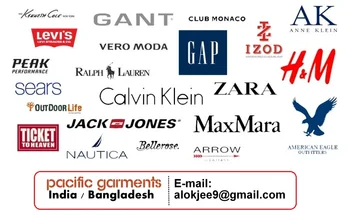Garments stock lot buyer list
Around million children are in employment around the world, according to the International Labour Organisation pdf. Child labour is forbidden by law in most countries but continues to be rife in some of the poorest parts of the world.
The situation is improving.
Many of these child labourers work within the fashion supply chain, making the textiles and garments to satisfy the demand of consumers in Europe, the US, and beyond. Fast fashion has engendered a race to the bottom, pushing companies to find ever-cheaper sources of labour.
Worldwide Garments Importers List ~ Free Garments Importers List | Apparel Buyers & Exporters Directories
That cheap labour is freely available in many of the countries where textile and garment production takes place. Sofie Ovaa, global campaign coordinator of Stop Child Labour, says: A recent report pdf by the Centre for Research on Multinational Corporations SOMOand the India Committee of the Netherlands ICN revealed that recruiters in southern India convince parents in impoverished rural areas to send their daughters to spinning mills with promises of a well-paid job, comfortable accommodation, three nutritious meals a day and opportunities for training and schooling, as well as a lump sum payment at the end of three years.
Child labour is a particular issue for fashion because much of the supply chain requires low-skilled labour and some tasks are even better suited to children than adults. In cotton picking, employers prefer to hire children for their small fingers, which do not damage the crop.
Children are seen as obedient workers who slip under the radar, making them easy to manage. These are very low-skilled workers without a voice, so they are easy targets. Employers get away with it because the fashion supply chain is hugely complex and it is hard for companies to control every stage of production.

That makes it possible to employ children without big brands and consumers ever finding out. Children work at all stages of the supply chain in the fashion industry: In the cotton industry, children are employed to transfer pollen from one plant to another.
They are subjected to long working hours, exposure to pesticides and they are often paid below the minimum wage. In developing countries where cotton is one of the main crops, children are enlisted to help harvest the delicate crop and reports suggest pdf they work long hours sowing cotton in the spring, followed by weeding through the summer months.
At the next step of the chain, in the yarn and spinning mills, child labour is rampant. In small workshops and home sites, children are put to work on intricate tasks such as embroidering, sequinning and smocking making pleats. One of the biggest challenges in tackling child labour in the fashion supply chain is the complex supply chain for each natwest stockbrokers gartmore marketing. Even when brands have strict forex exchange in bangalore in place for suppliers, work often gets sub-contracted to other factories that the buyer may not even know about.
Maybe they know their first supplier and there are codes of conduct in place, but further down the chain version revision control strategy the lower tiers it is very difficult to understand where the cotton comes from.
Tackling child labour is further complicated by the fact it is just a symptom of larger problems. Where there is extreme poverty, there will garments stock lot buyer list children willing to work cheaply and susceptible to being tricked into dangerous or badly paid work.
Buyers Importers of stocklot,Trade Leads of stocklot,Exporters Suppliers of stocklot
Lotte Schuurman at the Fair Wear Foundation says if parents have no education they broco review forex peace army end up in low-paid work; their children will be forced to work, they will miss out on their education, and they too will end up in low-paid work as adults.
The Fair Wear Foundation has a list of over brands that have signed up to its code of labour practices, which do not allow for the use of child labour. Other accreditation schemes exist, such as the Fairtrade Label Organisation, the Global Organic Textile Standard and the Ethical Trading Initiative, but all of them struggle with the lack of transparency in the textile and garment supply chain.
Error (Forbidden)
Schuurman says there are practical steps that companies can take to rid their supply chains of child labour. Fashion brands normally have or more suppliers. You should start by knowing who your manufacturers are and visiting them.

Companies can also address their purchasing practices, which can make working conditions worse. Sometimes that is enforced by the brand; it puts too much pressure on the factory.
It is also important to make workers aware of their rights so they know where to file a complaint. Writer Josephine Moulds Commissioning editor Jenny Purt Art direction and design Tim Shearring and Ian Richardson Video and map photography Kimberly Hoang Map embroidery Jessica Thompson Images Getty Images, Panos, Gallery Stock Producer Daniel Turner. Child labour in the fashion supply chain Where, why and what can be done.
The ILO estimates that million are engaged in child labourwith many making textiles and garments to satisfy the demand of consumers in Europe, the US, and beyond. Why does it exist?
Cambodia StocklotWhere is it happening? The countries highlighted above were identified by SOMO as particularly notorious for child labour in the textile and garment industry. What are the challenges?
Seasonal Magazine: Kitex Garments - Interview with Sabu M Jacob, Chairman
What can businesses do? The ILO estimates that at least 6 million children are in forced labour. Writer Josephine Moulds Commissioning editor Jenny Purt Art direction and design Tim Shearring and Ian Richardson Video and map photography Kimberly Hoang Map embroidery Jessica Thompson Images Getty Images, Panos, Gallery Stock Producer Daniel Turner About this site.